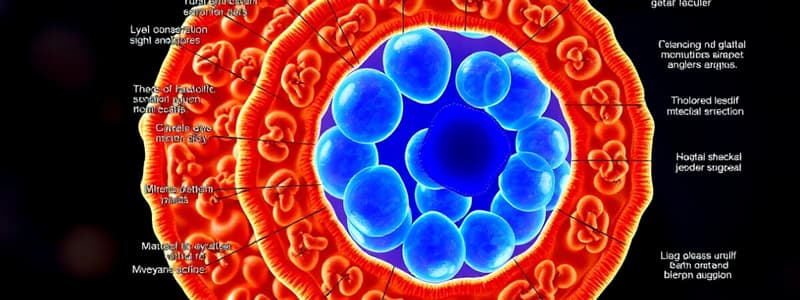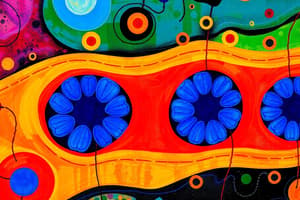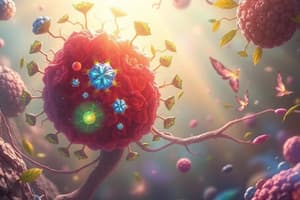Podcast
Questions and Answers
What is produced in the aerobic respiration process?
What is produced in the aerobic respiration process?
- Oxygen and Glucose
- Glucose and Water
- ATP and Oxygen
- Carbon Dioxide and Water (correct)
Which macromolecule is made of amino acids?
Which macromolecule is made of amino acids?
- Carbohydrates
- Proteins (correct)
- Lipids
- Nucleic Acids
How much energy is typically passed on to the next trophic level in an energy pyramid?
How much energy is typically passed on to the next trophic level in an energy pyramid?
- 5%
- 20%
- 50%
- 10% (correct)
Which process involves the breakdown of larger molecules into smaller ones?
Which process involves the breakdown of larger molecules into smaller ones?
What component of the cell membrane is primarily responsible for its structure?
What component of the cell membrane is primarily responsible for its structure?
What type of molecules are starch and glycogen categorized as?
What type of molecules are starch and glycogen categorized as?
What is the primary role of enzymes in biological systems?
What is the primary role of enzymes in biological systems?
Which cycle includes both respiration and photosynthesis?
Which cycle includes both respiration and photosynthesis?
What element is present in proteins that is not found in carbohydrates?
What element is present in proteins that is not found in carbohydrates?
Which of the following is NOT a function of lipids in the body?
Which of the following is NOT a function of lipids in the body?
Which life function is primarily responsible for energy production within cells?
Which life function is primarily responsible for energy production within cells?
What is the function of the ribosome in a cell?
What is the function of the ribosome in a cell?
What is necessary for a species to survive even though it may not be necessary for an individual organism?
What is necessary for a species to survive even though it may not be necessary for an individual organism?
Which part of the cell serves as a semi-permeable barrier regulating what enters and exits the cell?
Which part of the cell serves as a semi-permeable barrier regulating what enters and exits the cell?
What is the primary purpose of chloroplasts in plant cells?
What is the primary purpose of chloroplasts in plant cells?
What process produces oxygen and glucose during photosynthesis?
What process produces oxygen and glucose during photosynthesis?
Which organelle is responsible for controlling the cell and containing genetic information?
Which organelle is responsible for controlling the cell and containing genetic information?
What primary function does the vacuole serve in a plant cell?
What primary function does the vacuole serve in a plant cell?
Which of the following is NOT a level of organization in biological systems?
Which of the following is NOT a level of organization in biological systems?
Which light color is known to promote the least amount of photosynthesis?
Which light color is known to promote the least amount of photosynthesis?
Flashcards
Respiration
Respiration
Process that makes energy (ATP) through the breakdown of glucose.
Aerobic Respiration
Aerobic Respiration
Respiration requiring oxygen to produce a large amount of ATP (36 ATPs).
Anaerobic Respiration
Anaerobic Respiration
Respiration without oxygen, resulting in smaller amount of ATP (few ATPs).
Mitochondria
Mitochondria
Signup and view all the flashcards
Energy Pyramid
Energy Pyramid
Signup and view all the flashcards
Food Web
Food Web
Signup and view all the flashcards
Food Chain
Food Chain
Signup and view all the flashcards
Decomposer
Decomposer
Signup and view all the flashcards
Organic Molecules
Organic Molecules
Signup and view all the flashcards
Macromolecule
Macromolecule
Signup and view all the flashcards
Monosaccharide
Monosaccharide
Signup and view all the flashcards
Protein
Protein
Signup and view all the flashcards
Amino Acid
Amino Acid
Signup and view all the flashcards
Enzyme
Enzyme
Signup and view all the flashcards
Hydrolysis
Hydrolysis
Signup and view all the flashcards
Dehydration Synthesis
Dehydration Synthesis
Signup and view all the flashcards
Lipid
Lipid
Signup and view all the flashcards
Carbohydrate
Carbohydrate
Signup and view all the flashcards
Life Functions
Life Functions
Signup and view all the flashcards
Nutrition
Nutrition
Signup and view all the flashcards
Transport
Transport
Signup and view all the flashcards
Respiration
Respiration
Signup and view all the flashcards
Excretion
Excretion
Signup and view all the flashcards
Growth
Growth
Signup and view all the flashcards
Synthesis
Synthesis
Signup and view all the flashcards
Regulation
Regulation
Signup and view all the flashcards
Reproduction
Reproduction
Signup and view all the flashcards
Metabolism
Metabolism
Signup and view all the flashcards
Homeostasis
Homeostasis
Signup and view all the flashcards
Levels of Organization
Levels of Organization
Signup and view all the flashcards
Organelle
Organelle
Signup and view all the flashcards
Cell
Cell
Signup and view all the flashcards
Tissue
Tissue
Signup and view all the flashcards
Organ
Organ
Signup and view all the flashcards
Organ System
Organ System
Signup and view all the flashcards
Organism
Organism
Signup and view all the flashcards
Cell Membrane
Cell Membrane
Signup and view all the flashcards
Cell Wall
Cell Wall
Signup and view all the flashcards
Cytoplasm
Cytoplasm
Signup and view all the flashcards
Nucleus
Nucleus
Signup and view all the flashcards
Mitochondria
Mitochondria
Signup and view all the flashcards
Ribosome
Ribosome
Signup and view all the flashcards
Vacuole
Vacuole
Signup and view all the flashcards
Chloroplast
Chloroplast
Signup and view all the flashcards
Photosynthesis
Photosynthesis
Signup and view all the flashcards
Leaves
Leaves
Signup and view all the flashcards
Stomates
Stomates
Signup and view all the flashcards
Guard Cells
Guard Cells
Signup and view all the flashcards
Chlorophyll
Chlorophyll
Signup and view all the flashcards
Study Notes
Life Functions
- Living organisms take in materials for growth and repair (nutrition)
- Materials are moved through the organism (transport)
- Nutrients are broken down to make energy (respiration)
- Waste products are removed (excretion)
- Living things increase in size or cell number (growth)
- Smaller molecules become larger molecules (synthesis)
- Activities are controlled and coordinated (regulation)
- Offspring are produced (reproduction). Reproduction is not needed for an individual organism to survive, but is necessary for a species to continue
Cells
- Levels of organization include organelles, cells, tissues, organs, organ systems, and organisms
- Organelles are specialized parts of cells with specific jobs
- Cells are the basic units of life, each performing many functions
- Tissues are groups of similar cells working together
- Organs are groups of different tissues working together
- Organ systems are multiple organs working together
- Organisms are many organ systems working together
Parts of the Cell
- Cell membrane is a semi-permeable layer enclosing the contents of the cell
- Cell wall supports plant cells
- Cytoplasm is a gel-like substance holding organelles
- Nucleus contains genetic information
- Mitochondria produce energy through respiration
- Ribosomes synthesize proteins
- Vacuoles store materials
- Chloroplasts perform photosynthesis (only in plant cells)
Plants
- Leaves have guard cells/stomates that control gas exchange (CO2 in, O2 out), and water movement
- Stomates open and close to maintain homeostasis under various conditions
- Photosynthesis takes place in chloroplasts, located primarily in the top layer of leaves
- Photosynthesis converts light energy to chemical energy (sugars) using carbon dioxide and water
Respiration
- Aerobic respiration needs oxygen to metabolize glucose, yielding energy and producing carbon dioxide as a byproduct
- Anaerobic respiration needs no oxygen, and results in less energy being produced.
Energy Pyramids
- Energy in an ecosystem flows from producers (plants) to consumers (primary, secondary, tertiary)
- Approximately 10% of energy is transferred to each successive level
Body Systems
- Nervous system sends messages throughout the body
- Circulatory system moves materials around the body
- Respiratory system is responsible for gas exchange
- Excretory system removes waste products
- Digestive system breaks down food into usable components
Studying That Suits You
Use AI to generate personalized quizzes and flashcards to suit your learning preferences.




